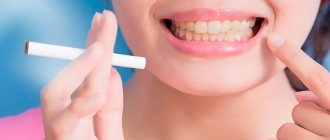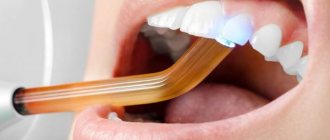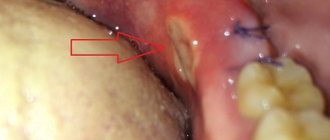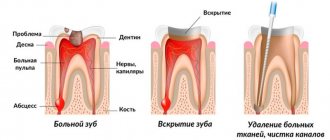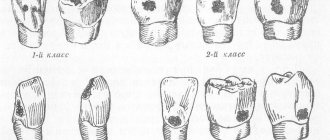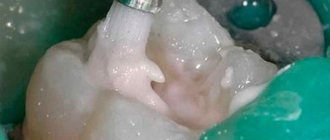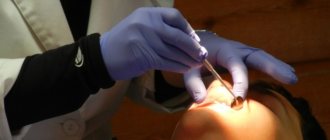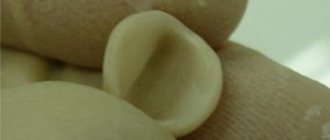If the filling interferes after treatment
Even in the doctor’s office, after installing the filling, be sure to make sure that the restored tooth is not in the way (move your jaw back and forth, sideways, carefully close your teeth). The filling should not be felt or change the bite. Don’t be shy about talking to your doctor about any discomfort—sometimes the final stage of filling treatment can take even longer than removing cavities and applying filling material.
After treatment, anesthesia wears off within 1.5-2 hours. If a conductor type was used, then after 4-6 hours. Now you are beginning to fully feel the treated tooth, you can fully close your jaws and understand how comfortable you are after filling.
If you experience slight discomfort, it feels like the tooth is a little larger and your jaws aren't closing quite tightly—this is normal. The fact is that now you have been given a new filling in accordance with the bite, that is, with the shape and position of the tooth located on the opposite side. The treated tooth became taller than before - after all, there was caries and the old filling sagged. Therefore, if there is no sharp pain and obvious rejection, be patient for a few days. If the situation normalizes and you get used to it, then there is no reason to see a doctor. If discomfort persists for 1-2 weeks, you should visit your dentist to have the filling corrected.
What you need to know about remineralization therapy
The goal of this treatment is to increase calcium levels. To do this, tooth enamel is treated with special preparations, after which exposure to fluoride substances is carried out.
One of the best treatments for hypersensitivity is Tiefenfluorid, a two-component enamel-sealing liquid:
- Component 1 - highly active calcium hydroxide
- Component 2 - highly active fluorine
Treatment involves sequential treatment of tooth enamel with both components of the drug; It is recommended to carry out a couple of procedures with a short break.
Important! The use of the drug Tiefenfluorid and others like it is effective only if all teeth have been treated for caries and do not have mechanical defects (wedge-shaped, etc.). All dental problems must be eliminated before treatment with an enamel-sealing liquid.
How long should you not eat after having a filling installed?
If a filling made of chemical composites is installed, then you should refrain from eating and drinking for 2 hours. This is due to the fact that the material requires a certain time for final shrinkage and hardening.
If a “light” composite filling is installed, you can drink immediately, but you should abstain from food for 1.5-2 hours. But the reason is not in the material (it hardens a few seconds after application), but in anesthesia - with reduced sensitivity of the mucous membranes during eating, you can injure the tongue and mucous membranes of the cheeks on the inside.
During the day after the filling is installed, you should only eat warm foods - excessively hot or cold foods can lead to changes in the shape of the filling. It is necessary to chew food on the opposite side for the first day - this will allow the material to fully “adhere” to the tissues and take the desired shape, without the risk of damage.
Traditional medicine
Dental hypersensitivity has been known since ancient times, so in folk medicine there are many remedies and methods that can be used today.
Here are just a few sensible tips from traditional medicine:
- Consume natural (chemical-free) cow's and goat's milk.
- Eat foods high in vitamin D (fermented milk products, butter, fish, etc.)
- Use tea tree oil as a rinse (three drops per glass of water); The mask has antibacterial properties, prevents the development of caries, and eliminates unpleasant odors.
Why does a tooth hurt after a filling is installed?
Minor soreness may persist for several days or even a couple of weeks, which is explained by overheating of the tissue due to the use of boron. In some situations, for example, with deep caries or when treating front teeth, increased sensitivity can persist even for several months. But in such a situation, you should still consult a doctor for an x-ray to make sure that there is no infected tissue left under the filling and that inflammation has not affected the nerve.
If the pain intensifies, the filling darkens, black spots appear under it - all this indicates that the treatment was carried out poorly and re-inflammation has begun. This is a reason to see a doctor as soon as possible.
In what cases is it important to visit a doctor?
Visit a specialist urgently if you have:
- Acute toothache;
- Pain combined with bleeding gums;
- Dull pain that sharply worsens when eating cold or hot food (this may indicate untreated chronic pulpitis);
- The temperature has risen;
- Discharge from the gums or changes in the gum tissue are observed.
If you don't trust the dentist who treated your tooth before symptoms began, find a better professional. The specialists at Dr. Granov’s clinic are ready to help you with dental treatment and correct the mistakes of others.
We are responsible for the health of our patients and choose progressive, safe, effective treatment methods.
What to do if your gums hurt after filling
The gums in the area where the anesthesia was administered may ache for several days - this is completely normal and does not require any measures. The mucous membrane may also be slightly inflamed if special rings were used during treatment, which are placed on the tooth to form the correct shape of its crown. The gums can also be damaged if the doctor had to install the filling material in close proximity to the mucous membrane or even under it - in such a situation the gums are deliberately pushed back. Therefore, pain is a normal reaction to external intervention.
All of these conditions are variations of the norm. But if the pain intensifies, redness and swelling of the mucous membrane progresses, you need to consult a doctor.
Classic filling
The conventional filling procedure does not imply penetration into the tooth pulp and depulpation of the root canals. This manipulation is much simpler compared to endodontic intervention, however, not everything is so obvious here. First, conventional therapeutic procedures are performed more frequently. Secondly, the quality of materials and the level of specialists in Russia are often low, so severe pain after filling a tooth and other complications are by no means uncommon even with the simplest manipulations. Below is a table that describes the most common causes of complications and pain after filling.
| Type of complication | Description | Pain symptoms |
| Mechanical trauma to the pulp during filling (pulp perforation) | It occurs when the bur is used roughly and carelessly, when the partition between the pulp and dentin is destroyed. Modern dentistry offers conservative ways to eliminate such complications, but often only a depulpation procedure can help. | With this problem, the tooth “pulsates” after filling and reacts sharply to cold and hot. The pain is severe and practically does not subside. |
| Burn of dentin or pulp (tooth overheating) | Usually occurs when the cooling system of the drill malfunctions, when the tooth tissue gets burned during the operation of the drill. In the most severe cases, the patient develops pulpitis and periodontitis. | If your tooth ache after filling and the pain does not go away for a long time, it is quite possible that you have a dentin burn. If, after filling, the tooth reacts sharply to hot and cold or there is throbbing pain, then most likely the pulp was affected. |
| Incorrectly installed seal | Overbite and overhanging filling edges are among the most common causes of pain. Incorrect closure of the dentition provokes very unpleasant sensations. | Does your tooth hurt when you bite it after filling? Perhaps the problem is an incorrectly installed seal. If the cause is not eliminated in time, the tooth reacts painfully even with gentle pressure. |
| Error when choosing material | There are more than a dozen filling materials on the market, many of which are not suitable for everyone due to their properties and components. | Acrylic composite and silicate cement fillings can cause allergies and inflammation. Amalgams and some light fillings can shrink, which is why the tooth hurts quite noticeably when bitten after filling. |
| Gum injuries | Damage to soft tissue is a very common occurrence during therapeutic manipulations (especially in the treatment of cervical caries). Serious injuries may require gum grafting. | Aching or cutting pain at the site of gum damage. |
How to properly perform hygiene procedures
After treatment, brush the filled tooth carefully, applying minimal pressure to it. Do not use rinses containing abrasive substances and alcohol, which can increase the plasticity of the material - this will lead to a change in the shape of the filling. Also, do not use excessively hard brushes - they can leave microcracks in the material, which will quickly damage it.
In general, you should take care of teeth with fillings in a completely standard way:
- daily brushing of teeth twice a day - in the morning before breakfast and in the evening after all meals, after - rinsing the mouth with water and rinse,
- To clean the area of filled teeth after eating, it is better to replace dental floss with an irrigator. If you floss carelessly, you can touch the installed filling, especially if there are thin edges of the tooth, which will lead to its loss.
What can hurt a tooth?
A tooth consists of a root and a crown. It is covered as a frame with dentin and cement in the root area, dentin and enamel in the crown area. These are hard tissues that lack nerve endings, so they cannot hurt. Inside the tooth there is a space filled with tissue penetrated by branches of nerves. This is pulp. The pulp is also contained in the canals that connect the tooth cavity to the root. Any diseases (for example, inflammation - pulpitis) and injuries to the pulp are very painful.
Periodontitis is also a very painful disease - inflammation of the periodontium - the ligament that holds the root in the socket, since there are also many branches of nerves in the periodontium.
Is it necessary to follow a diet after caries treatment?
From the diet as a whole after caries treatment (especially if a large filling is installed and your own tooth has very thin walls), it is recommended to remove too hard foods - toffees, chewing gum, grilled fruit, nuts, etc. Or chew them with teeth located on the opposite side (if they do not have fillings).
Minimize the amount of consumed foods and drinks that contain coloring pigments (tea, coffee, beets) - under their influence, the filling material may slightly change its shade. This rule is especially relevant when restoring front teeth.
Methods for reducing tooth sensitivity
| Root cause of hypersensitivity | Recommended Actions |
| Presence of carious teeth Presence of defects in the form of white spots Defects in enamel in the form of a “blade” Exposure of the tooth neck Absence of external pathology | Cure the source of infection Remineralization therapy Filling, restoration of enamel Removal of tartar, treatment of the exposed neck (and, if necessary, the root of the tooth) with special means Fluoridation (local treatment to increase the content of calcium and fluorine in tooth enamel) |
How to maintain your treatment guarantee
As a rule, therapeutic treatment, that is, dental filling, is guaranteed from 6 months to 2 years - depending on the volume of work and the complexity of the situation. To maintain the guarantee, the patient must strictly follow all recommendations: do not overload the tooth, do not use it for other purposes (for example, open beer bottles), and also regularly see the doctor in accordance with the individual schedule of medical examinations. Unfortunately, many patients forget about this, and it is the last point that is the key to maintaining the guarantee for treatment.
You need to visit a doctor 1-2 times a year. During a preventive examination, the dentist will be able to make sure that the filling is in good condition and that caries does not develop again underneath it.
Causes of increased dental sensitivity
As is known, tooth enamel acts as a shield that protects the nerve processes that penetrate the dentin tissue and the dental nerve itself. As the enamel becomes thinner or destroyed, its protective functions decrease, making the tooth vulnerable (in the absence of the necessary protection, various agents stimulate the transmission of signals to the dental nerve, which provokes pain).
Thus, the reason for increased tooth sensitivity is the unsatisfactory condition of the enamel, which, in turn, can develop under the influence of various factors.
Among the main factors for the deterioration of tooth enamel:
- Violation of the rules of hygiene when caring for the oral cavity - an incorrectly selected toothbrush, the wrong choice of toothpaste (for example, aggressive whitening pastes), ignorance of the basics of proper brushing of teeth (including intense rubbing).
- Pathological processes in the body are diseases that cause disturbances in mineral metabolism, in particular calcium deficiency.
- Dental diseases - destruction of enamel is caused by advanced caries, the presence of broken fillings in the oral cavity, accumulation of tartar, etc.
- Pregnancy is one of the conditions that contribute to the leaching of calcium from the body.
- Constant smoking accelerates the formation of tartar and destroys enamel.
- Bruxism (teeth grinding) - contributes to the mechanical destruction of enamel.
- Exposure to acids - increased consumption of foods such as fruits, berry and fruit juices, coffee, carbonated drinks with dyes.
- Aggressive whitening - in pursuit of a Hollywood smile, we sometimes agree to aggressive whitening procedures (up to removing the top layer of enamel), without thinking about the consequences.
